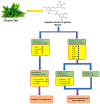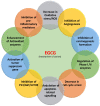Potential Therapeutic Targets of Epigallocatechin Gallate (EGCG), the Most Abundant Catechin in Green Tea, and Its Role in the Therapy of Various Types of Cancer
- PMID: 32660101
- PMCID: PMC7397003
- DOI: 10.3390/molecules25143146
Potential Therapeutic Targets of Epigallocatechin Gallate (EGCG), the Most Abundant Catechin in Green Tea, and Its Role in the Therapy of Various Types of Cancer
Abstract
Epigallocatechin-3-gallate (EGCG), an active compound of green tea and its role in diseases cure and prevention has been proven. Its role in diseases management can be attributed to its antioxidant and anti-inflammatory properties. The anti-cancer role of this green tea compound has been confirmed in various types of cancer and is still being under explored. EGCG has been proven to possess a chemopreventive effect through inhibition of carcinogenesis process such as initiation, promotion, and progression. In addition, this catechin has proven its role in cancer management through modulating various cell signaling pathways such as regulating proliferation, apoptosis, angiogenesis and killing of various types of cancer cells. The additive or synergistic effect of epigallocatechin with chemopreventive agents has been verified as it reduces the toxicities and enhances the anti-cancerous effects. Despite its effectiveness and safety, the implications of EGCG in cancer prevention is certainly still discussed due to a poor bioavailability. Several studies have shown the ability to overcome poor bioavailability through nanotechnology-based strategies such as encapsulation, liposome, micelles, nanoparticles and various other formulation. In this review, we encapsulate therapeutic implication of EGCG in cancer management and the mechanisms of action are discussed with an emphasis on human clinical trials.
Keywords: EGCG; bioavailability; cancer; cell signaling pathways; clinical trials; synergistic effect.
Conflict of interest statement
The authors declare no conflict of interest.
Figures




References
-
- All Cancers [Internet] [(accessed on 15 June 2019)];2018 Available online: http://gco.iarc.fr/today.
Publication types
MeSH terms
Substances
LinkOut - more resources
Full Text Sources
Medical

